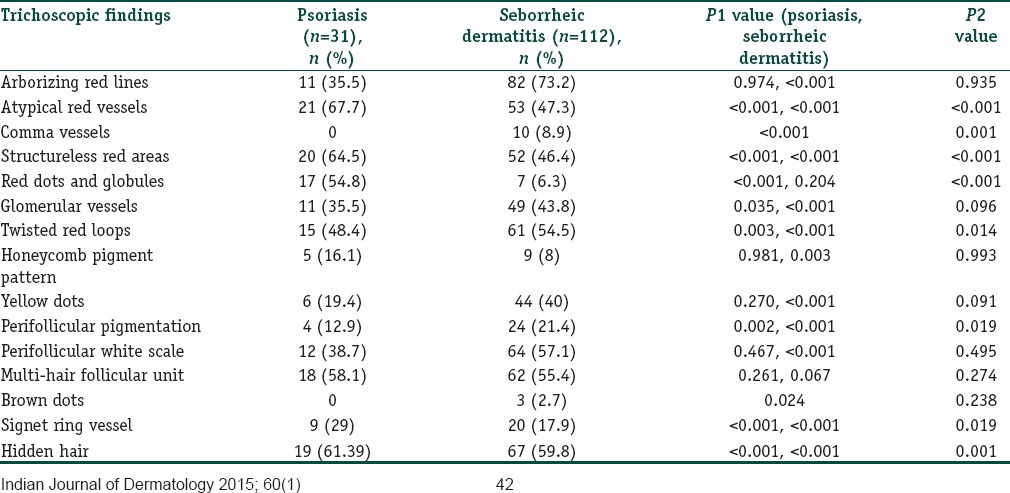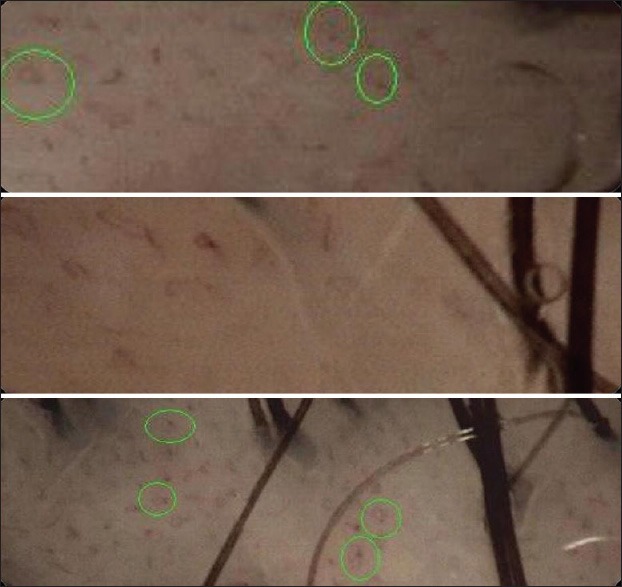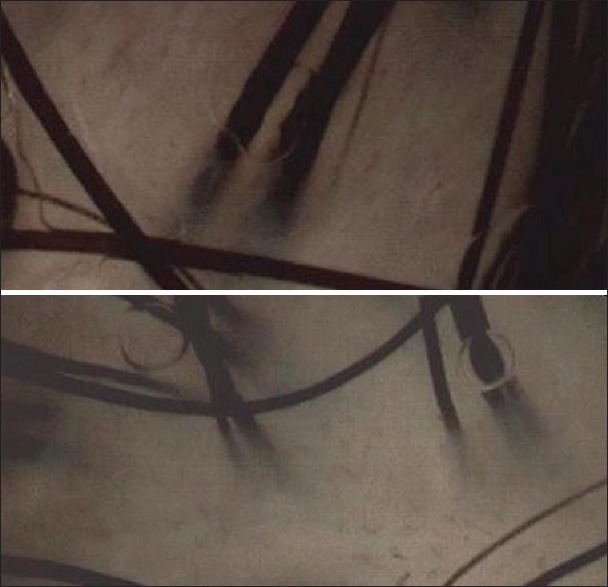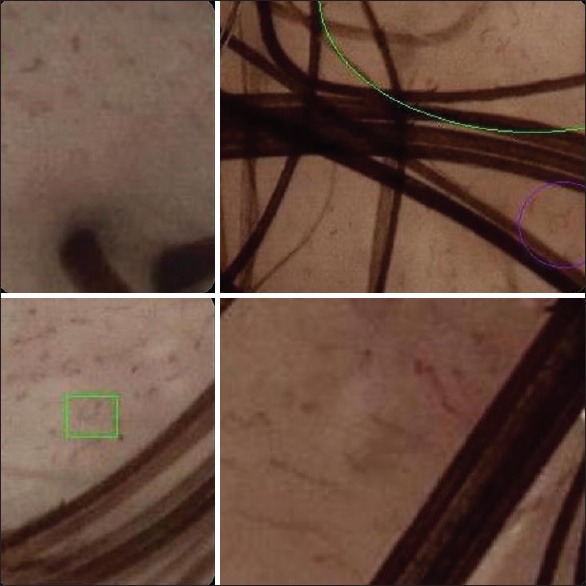Abstract
Background:
Psoriasis and seborrheic dermatitis are both chronic erythemato-squamous dermatoses that can involve the scalp. It may be difficult to differentiate these two diseases when there is isolated scalp involvement. Recently, trichoscopy is commonly used to differentiate noncicatricial alopecias including psoriasis and seborrheic dermatitis that can lead to telogen effluvium (TE).
Objectives:
The objective of this study is to evaluate the trichoscopic figures that may help to differentiate scalp psoriasis and seborrheic dermatitis.
Materials and Methods:
Thirty one with scalp psoriasis and 112 patients with seborrheic dermatitis were enrolled. Trichoscopic examinations were performed using a videodermatoscope (MoleMax 3®). Trichoscopic findings of scalp psoriasis and seborrheic dermatitis were compared with each other, with 100 healthy individuals and with other noncicatricial alopecias including female androgenetic alopecia (FAGA) (n: 138), male androgenetic alopecia (n: 63), FAGA of male pattern (FAGA.M) (n: 5), alopecia areata (39), TE (n: 22) and trichotillomania (n: 4).
Results:
Atypical red vessels, red dots and globules (RDG), signet ring vessels (SRV), structureless red areas and hidden hairs (HH) were statistically more common in psoriasis while twisted red loops and comma vessels (CV) in seborrheic dermatitis. RDG were considered as the characteristic videodermatoscopic figure for psoriasis and arborizing red lines and CV for seborrheic dermatitis. In comparison with previous reports, our study yielded two new trichoscopic structures supporting the diagnosis of psoriasis; HH and SRV. Besides, according to our study, CV were described for the first time in seborrheic dermatitis and considered to be specific for seborrheic dermatitis.
Conclusion:
This study confirmed that trichoscopy might be useful in differentiating scalp psoriasis and seborrheic dermatitis from each other and from other noncicatricial alopecia with three trichoscopic structures as HH, SRV and CV.
Keywords: Dermatoscopy, dermoscopy, psoriasis, seborrheic dermatitis, trichoscopy
What was known?
Differentiating scalp psoriasis and seborrheic dermatitis is difficult either clinically and histopathologically. Recently, trichoscopy is commonly used to differentiate these two diseases. Several reports have described the peculiar dermoscopic features of psoriasis and considered red globules as the as the key diagnostic criterion for psoriasis and twisted red loops as the characteristic videodermatoscopic figure of scalp psoriasis in comparison with seborrheic dermatitis. In addition to this, red dots and globules, twisted red loops and glomerular vessels are known as common dermoscopic findings in psoriasis while atypical red vessels, arborizing red lines and structureless red areas are common in seborrheic dermatitis.
Introduction
Psoriasis is a chronic relapsing erythemato-squamous dermatitis characterized by abnormal keratinocyte hyperproliferation resulting in thickening of the epidermis (producing well-circumscribed clinical plaques) and stratum corneum (producing scale).[1,2,3,4] In its classic presentation, the disease presents as well-circumscribed reddish and scaly papules and plaques typically on the elbows, knees and scalp, in addition to other cutaneous sites. Scalp psoriasis presents as sharply demarcated plaques with silvery-white scaling. Sometimes the lesions involve the forehead, retroauricular area and back of the neck.[5]
Seborrheic dermatitis is a chronic relapsing erythematous scaly skin disease characterized by red, flaking, greasy areas on the skin, most commonly on the scalp, nasolabial folds, ears, eyebrows and chest.[6,7] Differentiating these two diseases is difficult either clinically and histopathologically so now-a-days clinicians are searching for new methods such as trichoscopy and atomic force microscopy to distinguish these two diseases.[8,9,10] In this study, the trichoscopic findings of these two diseases were evaluated and compared with trichoscopy.
Materials and Methods
Patients
A total of 112 patients with seborrheic dermatitis and 31 patients with scalp psoriasis that referred to our dermatology out-patient clinic between January 2011 and June 2011 were enrolled. The diagnosis of seborrheic dermatitis was clinically established and confirmed by scalp biopsy in ambiguous cases (23/112) while the diagnosis of all patients with psoriasis was confirmed by biopsy. Trichoscopic findings of scalp psoriasis and seborrheic dermatitis were compared with each other and with other non-scarring alopecias including; female androgenetic alopecia (FAGA) (n: 138), male androgenetic alopecia (MAGA) (n: 63), FAGA of male pattern (FAGA.M) (n: 5), alopecia areata (AA) (n: 39), telogen effluvium (n: 22) and trichotillomania (TC) (n: 4).
Four and three psoriasis patients were also diagnosed as MAGA and FAGA consecutively. A total of 23 and 56 patients with seborrheic dermatitis presented with MAGA and FAGA consecutively.
Trichoscopic examination
To elucidate the vascular patterns more obviously and to avoid nosocomial infections and scales a solution combining propanol and butanediol and glycerol as immersion gel were used in limited cases. Trichoscopic evaluation of whole scalp was performed with a videodermatoscope (Molemax III®) and we obtained ×100 magnified photographs with a second camera.
Statistical analysis
All statistical analyses were performed using SPSS version 15.0 (SPSS Inc, Chicago, IL, USA). For continuous variables normality tests were performed with Kolmogorov-Smirnov test. Mann-Whitney U test was used to assess trichoscopic differences between scalp psoriasis and seborrheic dermatitis and Chi-Square test and Fisher's exact Chi-Square test were used to compare (the categorical data) trichoscopic differences with other noncicatricial alopecias. The level of significance for all analyses was set at P < 0.05.
Results
Comparison of trichoscopic findings in seborrheic dermatitis with other non-scarring alopecias
The age of patients with seborrheic dermatitis varied from 5 years to 80 years, with a median age of 32.8 ± 15.0 years. Female male ratio was 72/40. The patients had mostly type III Fitzpatrick's skin phenotype.
Common trichoscopic findings of seborrheic dermatitis were observed to be arborizing red lines (ARL), hidden hairs (HH), perifollicular white scale, twisted red loops (TRL), atypical red vessels (ARV), structureless red areas (SRA), glomerular vessels (GV), yellow dots (YD), perifollicular pigmentation (PP), signet ring vessels (SRV), comma vessels (CV), honeycomb pigment pattern and brown dots (BD) (P < 0.05) [Table 1].
Table 1.
Trichoscopic findings in scalp psoriasis and seborrheic dermatitis, comparison with other non-scarring alopecias (P1) and with each other (P2)

Comparison of trichoscopic findings in scalp psoriasis with other non-scarring alopecias
The age of the patients having scalp psoriasis varied from 17-73 years, with a median age of 43.3 ± 16.9 years. Female male ratio was 16/15. The patients had mostly type III Fitzpatrick's skin phenotype.
Common trichoscopic findings of scalp psoriasis were detected to be ARV, SRA, HH, red dots and globules (RDG), TRL, GV, SRV and PP (P < 0.05) [Table 1].
Comparison of trichoscopic findings in seborrheic dermatitis and scalp psoriasis
Some of the trichoscopic findings were detected both in seborrheic dermatitis and scalp psoriasis in comparison to other noncicatricial alopecias, but when compared with each other ARV, RDG, SRV, SRA and HH were significantly more common in psoriasis while TRL and CV were significantly more common in seborrheic dermatitis.
Discussion
The number of patients with psoriasis and seborrheic dermatitis that were evaluated in our study was higher than previous reports and in our study the findings of these patients were compared with those of other alopecias (n: 271) and healthy individuals (n: 100).[8,9] Videodermatoscope were used similar to Ross et al.[8] so better vascular images were obtained than Kim et al.[9] who used hand held dermatoscope.
YD
YD are known to be the marker of AGA and AA.[8,11,12] Twenty three patients with seborrheic dermatitis were having MAGA and 56 patients with seborrheic dermatitis were having FAGA at the same time so the frequency of YD (44/112, 40%, P < 0.001) in seborrheic dermatitis was attributed to concomitant AGA. Besides three patients with seborrheic dermatitis with BD (2.7%, P = 0.024) were also having AGA and this figure was also attributed to concomitant AGA.
SRV
This trichoscopic figure was described for the first time as a trichoscopic finding in our study[8,9] [Figure 1]. It is known that the earliest changes in dermal histopathologic findings in psoriasis can be non-specific and is followed by the development of dilated and slightly tortuous blood vessels within dermal papillae. This SRV sign is thought to be the result of these vascular alterations in psoriasis and seborrheic dermatitis.[1,2,3,4] This signet ring shape is thought to be formed by a slightly tortuous glomerular vessel and its elongated and dilated annular ring shaped vessel. This vascular sign was not observed in other alopecias so this sign was considered as a specific sign for these dermatoses when compared with other alopecias (n: 271) and healthy individuals (n: 100). Besides when psoriasis and seborrheic dermatitis was compared SRV sign was detected to be more common in psoriasis (P < 0.05).
Figure 1.

Signet ring vessels in black circles in two different patients with psoriasis in lesional scalps having active diseases (×100 magnification)
HH
Seborrheic dermatitis demonstrates psoriasiform hyperplasia and perifollicular predominantly lymphocytic infiltrates and focal parakeratosis particularly at the lips of follicular ostia (“shoulder parakeratosis”) histologically. Scalp involvement of psoriasis often shows more significant plaque formation caused by marked epidermal hyperplasia. Besides less common psoriatic lesions also include the follicular variant with perivascular and perifollicular inflammatory infiltrates and follicular plugging.[13,14] Due to these epidermal and perifollicular inflammation in these diseases, pilosebaseous unit with proximal hair shaft may look relatively hidden under a white-grey epidermal proliferation. Kim et al.[l0] investigated the hair shafts of scalp psoriasis and seborrheic dermatitis with atomic force microscopy and observed macropits on hair shafts. These perifollicular and epidermal proliferation and infiltration together with an altered hair shaft with macropits would cause the proximal hair shaft look like hidden under this thickened epidermis and so we thought to describe this appearance as HH with trichoscopy [Figure 2].
Figure 2.

Hidden hairs on the scalp of a patient with psoriasis (upper) and seborrheic dermatitis (lower) (×100 magnification)
TRL
TRL, which are thought to be a result of psoriasiform hyperplasia were seen on the entire scalp in Ross's[8] study while it was more common in the occipital area of our patients in our study. In Ross's study TRL were correlated with active disease on the other hand, all patients in our study were having active disease and a comparison could not be performed between remitting and stable disease.[8]
CV
In seborrheic dermatitis during the chronic phase there is marked psoriasiform hyperplasia with dilatation of the capillaries and venules of the superficial plexus, which makes it very similar to psoriasis except for the spongiosis.[13,15] Although this plexus was characterized as arborizing lines and ARV by trichoscopy during previous reports,[9] we detected some of them as comma shaped vessels in our study [Figure 3]. CV was observed only in seborrheic dermatitis when compared with other alopecias including psoriasis so we considered this sign as specific for seborrheic dermatitis.
Figure 3.

Comma vessels in three different patients with seborrheic dermatitis (×100 magnification)
Kim et al.[9] compared trichoscopic figures in their study and reported that RDG, TRL and glomerular vessels were mostly seen in psoriasis while ARV, ARL and SRA were seen in seborrheic dermatitis. On the other hand, in our study we observed RDG, ARV, SRA, HH, SRV mostly in psoriasis while TRL and CV mostly in seborrheic dermatitis.
Several reports have described the peculiar dermoscopic features of psoriasis and considered red globules as the as the key diagnostic criterion for psoriasis while Ross et al. reported TRL as the characteristic videodermatoscopic figure of scalp psoriasis in comparison with seborrheic dermatitis.[16,17,18,19,20] On the other hand, we considered RDG as the characteristic videodermatoscopic figure of psoriasis and ARL for seborrheic dermatitis according to our study.
In comparison with previous reports, our study yielded two new trichoscopic structures supporting the diagnosis of psoriasis; HH and SRV. Besides in our study, CV were firstly described in seborrheic dermatitis and since it was not detected in psoriasis it was thought to be specific for seborrheic dermatitis.
The limitations of our study were being non-double-blind and unable to reflect the variables of age, sex and the location of lesions. Besides all our patients enrolled in this study were having active disease so a comparison between remitting or stable disease could not be performed as well as the absence of correlation with histopathological findings.
In conclusion, this study shows trichoscopy may be useful in differentiating scalp psoriasis and seborrheic dermatitis with each other and with some other noncicatricial alopecias with these three new structures; HH, SRV and CV.
What is new?
With higher number of patients with psoriasis and seborrheic dermatitis than previous reports we compared dermoscopic findings of these dermatosis with those of other alopecias (n: 271) and healthy individuals (n: 100).[8,9] Our study yielded two new trichoscopic structures supporting the diagnosis of psoriasis; HH and SRV. Besides in our study, CV were firstly described in seborrheic dermatitis and CV were thought to be specific for seborrheic dermatitis. In addition to this, we considered RDG as the characteristic videodermatoscopic figure of psoriasis and ARL for seborrheic dermatitis according to our study.
Footnotes
Source of support: Nil
Conflict of Interest: Nil.
References
- 1.Ragaz A, Ackerman AB. Evolution, maturation, and regression of lesions of psoriasis. New observations and correlation of clinical and histologic findings. Am J Dermatopathol. 1979;1:199–214. doi: 10.1097/00000372-197900130-00002. [DOI] [PubMed] [Google Scholar]
- 2.Cox AJ, Watson W. Histological variations in lesions of psoriasis. Arch Dermatol. 1972;106:503–6. [PubMed] [Google Scholar]
- 3.Barr RJ, Young EM., Jr Psoriasiform and related papulosquamous disorders. J Cutan Pathol. 1985;12:412–25. doi: 10.1111/j.1600-0560.1985.tb00439.x. [DOI] [PubMed] [Google Scholar]
- 4.Gordon M, Johnson WC, Burgoon CF., Jr Histopathology and histochemistry of psoriasis. II. Dynamics of lesions during treatment. Arch Pathol. 1967;84:443–50. [PubMed] [Google Scholar]
- 5.van de Kerkhof PC, Franssen ME. Psoriasis of the scalp. Diagnosis and management. Am J Clin Dermatol. 2001;2:159–65. doi: 10.2165/00128071-200102030-00005. [DOI] [PubMed] [Google Scholar]
- 6.Sampaio AL, Mameri AC, Vargas TJ, Ramos-e-Silva M, Nunes AP, Carneiro SC. Seborrheic dermatitis. An Bras Dermatol. 2011;86:1061–71. doi: 10.1590/s0365-05962011000600002. [DOI] [PubMed] [Google Scholar]
- 7.Paus R, Peker S, Sundberg JP. Biology of hair and nails. In: Bolognia JL, Jorizzo JL, Rapini RP, editors. Dermatology. 2nded. London: Mosby Elsevier; 2008. pp. 965–87. [Google Scholar]
- 8.Ross EK, Vincenzi C, Tosti A. Videodermoscopy in the evaluation of hair and scalp disorders. J Am Acad Dermatol. 2006;55:799–806. doi: 10.1016/j.jaad.2006.04.058. [DOI] [PubMed] [Google Scholar]
- 9.Kim GW, Jung HJ, Ko HC, Kim MB, Lee WJ, Lee SJ, et al. Dermoscopy can be useful in differentiating scalp psoriasis from seborrhoeic dermatitis. Br J Dermatol. 2011;164:652–6. doi: 10.1111/j.1365-2133.2010.10180.x. [DOI] [PubMed] [Google Scholar]
- 10.Kim KS, Shin MK, Ahn JJ, Haw CR, Park HK. A comparative study of hair shafts in scalp psoriasis and seborrheic dermatitis using atomic force microscopy. Skin Res Technol. 2013;19:e60–4. doi: 10.1111/j.1600-0846.2011.00608.x. [DOI] [PubMed] [Google Scholar]
- 11.Lacarrubba F, Dall’Oglio F, Rita Nasca M, Micali G. Videodermatoscopy enhances diagnostic capability in some forms of hair loss. Am J Clin Dermatol. 2004;5:205–8. doi: 10.2165/00128071-200405030-00009. [DOI] [PubMed] [Google Scholar]
- 12.Inui S. Trichoscopy for common hair loss diseases: Algorithmic method for diagnosis. J Dermatol. 2011;38:71–5. doi: 10.1111/j.1346-8138.2010.01119.x. [DOI] [PubMed] [Google Scholar]
- 13.Braun-Falco O, Heilgemeir GP, Lincke-Plewig H. Histological differential diagnosis of psoriasis vulgaris and seborrheic eczema of the scalp. Hautarzt. 1979;30:478–83. [PubMed] [Google Scholar]
- 14.Murphy M, Kerr P, Grant-Kels JM. The histopathologic spectrum of psoriasis. Clin Dermatol. 2007;25:524–8. doi: 10.1016/j.clindermatol.2007.08.005. [DOI] [PubMed] [Google Scholar]
- 15.Houck G, Saeed S, Stevens GL, Morgan MB. Eczema and the spongiotic dermatoses: A histologic and pathogenic update. Semin Cutan Med Surg. 2004;23:39–45. doi: 10.1016/s1085-5629(03)00086-5. [DOI] [PubMed] [Google Scholar]
- 16.Zalaudek I, Argenziano G. Dermoscopy subpatterns of inflammatory skin disorders. Arch Dermatol. 2006;142:808. doi: 10.1001/archderm.142.6.808. [DOI] [PubMed] [Google Scholar]
- 17.Zalaudek I, Argenziano G, Di Stefani A, Ferrara G, Marghoob AA, Hofmann-Wellenhof R, et al. Dermoscopy in general dermatology. Dermatology. 2006;212:7–18. doi: 10.1159/000089015. [DOI] [PubMed] [Google Scholar]
- 18.Pan Y, Chamberlain AJ, Bailey M, Chong AH, Haskett M, Kelly JW. Dermatoscopy aids in the diagnosis of the solitary red scaly patch or plaque-features distinguishing superficial basal cell carcinoma, intraepidermal carcinoma, and psoriasis. J Am Acad Dermatol. 2008;59:268–74. doi: 10.1016/j.jaad.2008.05.013. [DOI] [PubMed] [Google Scholar]
- 19.Vázquez-López F, Zaballos P, Fueyo-Casado A, Sánchez-Martín J. A dermoscopy subpattern of plaque-type psoriasis: Red globular rings. Arch Dermatol. 2007;143:1612. doi: 10.1001/archderm.143.12.1612. [DOI] [PubMed] [Google Scholar]
- 20.Vázquez-López F, Marghoob AA. Dermoscopic assessment of long-term topical therapies with potent steroids in chronic psoriasis. J Am Acad Dermatol. 2004;51:811–3. doi: 10.1016/j.jaad.2004.05.020. [DOI] [PubMed] [Google Scholar]


